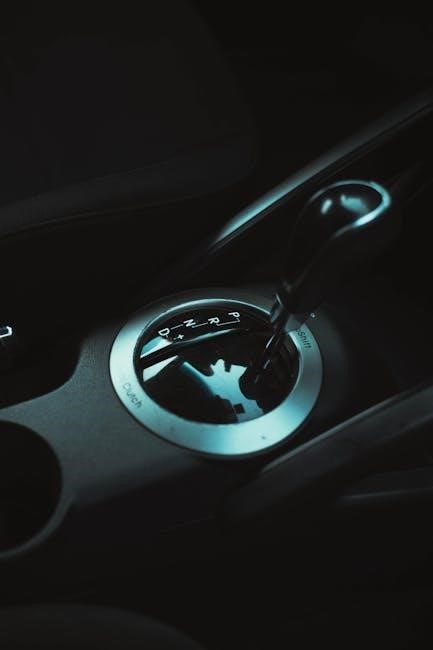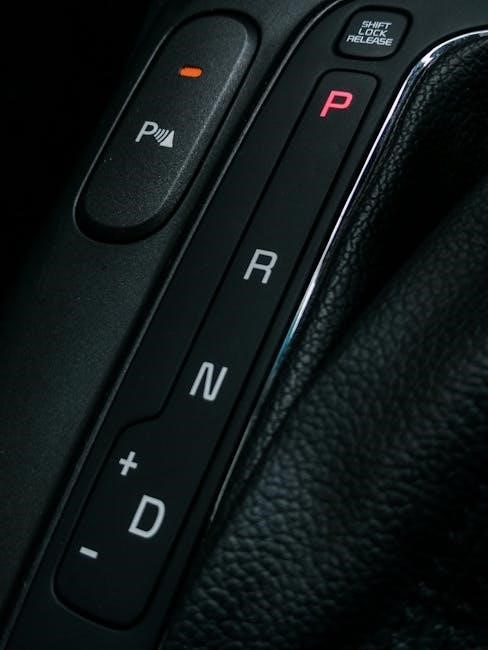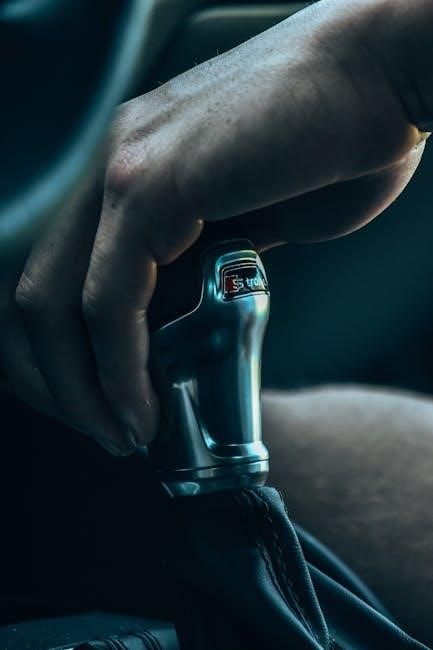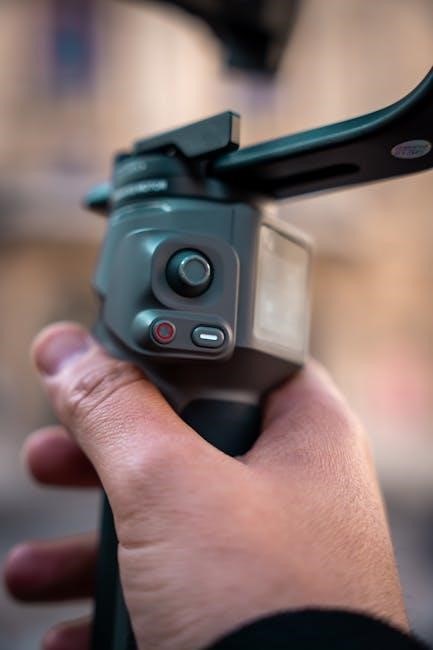Reversing a manual transmission requires understanding the gearshift pattern and using the clutch properly to engage reverse gear, typically located to the left of neutral, with a specific gear ratio for controlled speed.
Understanding the Reverse Gear
The reverse gear in a manual transmission is designed to move the car backward, functioning differently from other gears. When engaged, the transmission’s internal workings change, allowing the engine to drive the wheels in a direction opposite to forward motion. This gear has a specific ratio set to enable the car to move at a controlled speed while reversing. The reverse gear is typically the first gear to the left of neutral, and its location may vary depending on the type of transmission and vehicle. In some cases, the reverse gear may be shared with another gear, such as the sixth gear in some six-speed transmissions. Understanding how the reverse gear works and its location in a manual transmission is essential for safe and effective reversing. The reverse gear plays a crucial role in allowing drivers to maneuver their vehicles in tight spaces and park safely.
Locating the Reverse Gear in a Manual Transmission
To locate the reverse gear in a manual transmission, it is essential to familiarize yourself with the gearshift pattern. The reverse gear is usually found to the left of the neutral position, and its exact location may vary depending on the vehicle’s make and model. In most cases, the reverse gear is located at the far left of the gearshift, and it may require a slight push down or lift to engage. Some vehicles, such as the classic Land Rover Defender, have the reverse gear located to the left of the first gear. It is crucial to consult the vehicle’s manual or look for markings on the gearshift to determine the location of the reverse gear. By knowing the location of the reverse gear, drivers can quickly and easily engage it when needed, making reversing a safer and more efficient process. The gearshift pattern is typically illustrated on the gearshift knob or in the vehicle’s manual.

Engaging the Reverse Gear
Engaging reverse gear involves shifting into reverse, using the clutch and gearshift to change direction, with a smooth and controlled motion, every time, always.
Procedure for Engaging Reverse in a Floor-Based Manual Transmission
To engage reverse in a floor-based manual transmission, start by pressing the clutch pedal all the way down and shifting into neutral gear. Then, move the gearshift to the left and down to select reverse gear, feeling for the notch or click that indicates the gear is engaged. It is essential to use the clutch pedal and gearshift in a smooth and coordinated motion to avoid grinding or damaging the gears. With the gearshift in reverse, slowly release the clutch pedal while pressing the accelerator pedal at the same time, feeling for the car to start moving backward. This procedure requires practice to master, but with time and experience, it becomes second nature. By following these steps, drivers can safely and effectively engage reverse gear in a floor-based manual transmission. The process is straightforward and easy to learn, making it accessible to all drivers.
Special Considerations for Certain Vehicles
Certain vehicles, such as classic cars or those with unique transmission designs, may have different procedures for engaging reverse gear. For example, some six-speed manual transmissions may share the reverse gear with the sixth gear, requiring the driver to push the gearshift down to engage reverse. Other vehicles, like the Land Rover Defender, may have the reverse gear located to the left of the first gear. It is essential to consult the vehicle’s manual or manufacturer’s instructions to understand the specific procedure for engaging reverse gear in these cases. Additionally, some vehicles may have specific features or modifications that affect the reversing process, such as limited-slip differentials or specialized gearing. By being aware of these special considerations, drivers can ensure safe and effective operation of their vehicle in reverse. This knowledge can help prevent accidents and damage to the vehicle. Proper understanding is crucial.

Operating the Vehicle in Reverse
Manual transmission vehicles require careful control when reversing, using mirrors and checking surroundings to navigate safely and avoid obstacles with ease and precision always.
Controlling the Vehicle’s Speed while Reversing
Controlling the vehicle’s speed is crucial when reversing a manual transmission vehicle. This can be achieved by using the clutch and gearshift in conjunction with the brake pedal to regulate the vehicle’s speed. The driver should be aware of the surroundings and adjust the speed accordingly to avoid any obstacles or accidents. By slowly releasing the clutch while pressing the brake pedal, the driver can control the vehicle’s speed and come to a stop when necessary. It is also important to use the mirrors and check the surroundings to navigate safely. The driver should be cautious and patient when reversing, as it can be more challenging than driving forward. With practice and experience, controlling the vehicle’s speed while reversing becomes easier and more manageable. The key is to be smooth and gentle with the clutch and brake pedals to maintain control of the vehicle.
Using Mirrors and Looking Over Your Shoulder
When reversing a manual transmission vehicle, it is essential to use mirrors and look over your shoulder to navigate safely. The rearview mirror and side mirrors provide a clear view of the surrounding area, helping the driver to detect any obstacles or pedestrians. Additionally, looking over your shoulder allows the driver to see any blind spots and get a better view of the area behind the vehicle. By checking the mirrors and looking over your shoulder, the driver can avoid accidents and reverse safely. It is also important to be aware of the vehicle’s dimensions and clearance to avoid scraping or hitting anything. The driver should check the mirrors frequently and look over their shoulder to stay informed about the surroundings. This helps to build confidence and control when reversing a manual transmission vehicle, making it easier to maneuver in tight spaces. Regular checking of mirrors and looking over your shoulder becomes a habit with practice.

Common Challenges and Solutions
Drivers often face difficulty reversing manual transmission vehicles due to lack of practice and experience with gear shifting and clutch control mechanisms always.
Troubleshooting Issues with the Reverse Gear
To troubleshoot issues with the reverse gear, drivers should first check the gearshift pattern and ensure they are using the correct technique to engage reverse.
Common problems include grinding or difficulty shifting into reverse, which can be caused by worn or damaged gear components.
In some cases, the issue may be due to a lack of lubrication or excessive wear on the transmission’s internal parts.
Drivers can try adjusting their shifting technique or seeking assistance from a professional mechanic to diagnose and repair any issues with the reverse gear.
Regular maintenance, such as checking the transmission fluid level and condition, can also help prevent problems with the reverse gear.
By taking these steps, drivers can identify and address any issues with the reverse gear, ensuring smooth and safe operation of their vehicle.
Best Practices for Reversing a Manual Transmission Vehicle
Best practices for reversing a manual transmission vehicle include using a consistent and slow pace, checking mirrors and looking over the shoulder to ensure clear visibility.
Drivers should also use reference points, such as lines on the pavement or other vehicles, to gauge their distance and alignment.

Additionally, it is essential to be aware of potential hazards, such as pedestrians, cyclists, or other vehicles, and to use caution when reversing in tight spaces.
Regular practice and experience can help drivers develop the skills and confidence needed to reverse a manual transmission vehicle safely and effectively.
By following these best practices, drivers can minimize the risk of accidents and ensure a smooth and controlled reversal of their vehicle.
Furthermore, drivers should always be mindful of their surroundings and adjust their reversing technique accordingly, taking into account factors such as road surface and weather conditions.
